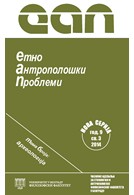„O, Vladimire, kralju dukljanski, tvrda glavo, srce ponosito!” Isaija Berlin i devetnaestovekovne interpretacije Života Svetog Vladimira od Zete
“Oh, Vladimir, King of Dioclea, Hard Headed, Heart Full of Pride!” Isaiah Berlin and Nineteenth Century Interpretations of the Live of Saint Vladimir of Dioclea
Author(s): Stefan Trajković FilipovićSubject(s): History, Language and Literature Studies
Published by: Филозофски факултет, Универзитет у Београду
Keywords: Saint Vladimir of Zeta; hagiography; Isaiah Berlin; Romanticism; historic play; historic novel; Lazar Lazarević; Jovan Sterija Popović; Stevan Sremac
Summary/Abstract: Saint Vladimir of Dioclea (i.e. Zeta) (c. 990–1016) left very few traces in medieval sources, and yet, for centuries now, he is present throughout the Balkans, notably in the areas of modern Albania, Bulgaria, Montenegro, Macedonia and Serbia. Compared to other notable medieval holy kings (e.g. Saint Stefan of Dečani), Saint Vladimir is a “vague” character; he was never as popular and his representations were never fully standardized nor uniformed – he is often simultaneously addressed with few names (Vladimir/Jovan/Jovan Vladimir) and with more than one title (an emperor/Tsar, king or prince). However, this “vagueness“, and yet persistence of the story about this saint makes an interesting research topic. The first elaborated narrative about the saint, the Life of Saint Vladimir of Dioclea, was published in 1601 as part of the Annals of the Priest of Dioclea, a chronicle depicting the history of an imagined early medieval Slavic dynasty and used as an introductory chapter to the Kingdom of Slavs by Mauro Orbini. The Life represents a developed hagiographic narrative with two main lessons – the value of (Saint Vladimir’s) martyrdom (following the model of Christ’s Passion) and of divine punishment awaiting the sinners. Furthermore, as part of the Annals of the Priest of Diocela (and of the Kingdom of Slavs), the Life depicts Vladimir as a Slavic holy king. Since its first edition, the Life remains the main source of inspiration and a starting point for most of the later interpretations of the story of Saint Vladimir’s life and death. In the focus of the article is a specific transformation that occurred in the nineteenth century regarding the story, within Serbian romantic literature. The approach to the transformation is based on the interpretation of the Romantic Movement provided by Isaiah Berlin in his 1965 Mellon lectures delivered in Washington DC (The Roots of Romanticism). I observe the transformation through the analysis of three representative nineteenth century interpretations of the story of Saint Vladimir: the historical dramas Vladimir and Kosara (1829, by Lazar Lazarević) and Vladislav (1843, by Jovan Sterija Popović) and the short story Vladimir of Dioclea (1888, by Stevan Sremac). Comparison of the Life with these narratives reveals significant shifts in main motives and lessons one finds in the story. Thus, instead of focusing on the notions of a holy man who serves as a tool of God’s will and of a Slavic holy king, one finds in nineteenth century interpretations the notions of man’s will, desire and utter loyalty to his own principles and values, one of them being his (Serbian) nation, as key ideas and supreme virtues. In spite of keeping certain hagiographic traits, these romantic interpretations bring reversals of main lessons of the story of Saint Vladimir and thus contribute to Berlin’s observation about the process of conscious creation of new mythologies within Romantic Movement with long-term consequences.
Journal: Етноантрополошки проблеми
- Issue Year: 9/2014
- Issue No: 3
- Page Range: 723-761
- Page Count: 39
- Language: Serbian

